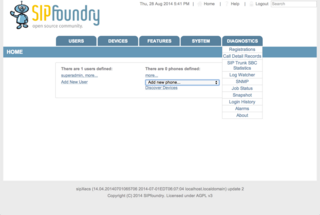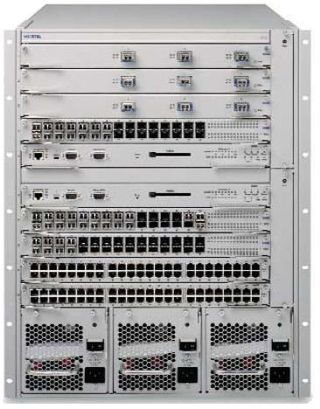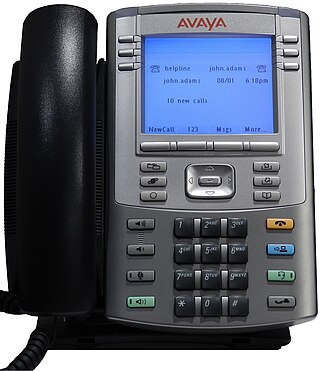The rational unified process (RUP) is an iterative software development process framework created by the Rational Software Corporation, a division of IBM since 2003. RUP is not a single concrete prescriptive process, but rather an adaptable process framework, intended to be tailored by the development organizations and software project teams that will select the elements of the process that are appropriate for their needs. RUP is a specific implementation of the Unified Process.

Avaya LLC, often shortened to Avaya, is an American multinational technology company headquartered in Morristown, New Jersey, that provides cloud communications and workstream collaboration services. The company's platform includes unified communications and contact center services. In 2019, the company provided services to 220,000 customer locations in 190 countries.
In software engineering, service-oriented architecture (SOA) is an architectural style that focuses on discrete services instead of a monolithic design. By consequence, it is also applied in the field of software design where services are provided to the other components by application components, through a communication protocol over a network. A service is a discrete unit of functionality that can be accessed remotely and acted upon and updated independently, such as retrieving a credit card statement online. SOA is also intended to be independent of vendors, products and technologies.

Skype for Business Server is real-time communications server software that provides the infrastructure for enterprise instant messaging, presence, VoIP, ad hoc and structured conferences and PSTN connectivity through a third-party gateway or SIP trunk. These features are available within an organization, between organizations and with external users on the public internet or standard phones.

SipXecs is a free software enterprise communications system. It was initially developed by Pingtel Corporation in 2003 as a voice over IP telephony server located in Boston, MA. The server was later extended with additional collaboration capabilities as part of the SIPfoundry project. Since its extension, sipXecs now acts as a software implementation of the Session Initiation Protocol (SIP), making it a full IP-based communications system.

The Nortel Norstar, previously the Meridian Norstar, was a small and medium-sized business digital key telephone system introduced by Nortel and later sold to Avaya. It featured automatic call distribution, and supported up to 192 extensions. In the United Kingdom it was sold by British Telecom, rebadged as the BT Norstar.
A service delivery platform (SDP) is a set of components that provides a service(s) delivery architecture for a type of service delivered to consumer, whether it be a customer or other system. Although it is commonly used in the context of telecommunications, it can apply to any system that provides a service. Although the TM Forum (TMF) is working on defining specifications in this area, there is no standard definition of SDP in industry and different players define its components, breadth, and depth in slightly different ways.
IBM App Connect Enterprise is IBM's premier integration software offering, allowing business information to flow between disparate applications across multiple hardware and software platforms. Rules can be applied to the data flowing through user-authored integrations to route and transform the information. The product can be used as an Enterprise Service Bus supplying a communication channel between applications and services in a service-oriented architecture.

Scopia, within the computer networking and telecommunications fields, is a series of unified communications products that provide meet-me, videoconferencing and online collaboration. The Scopia products include the Scopia XT Telepresence, Scopia XT7100 Room System, Scopia XT5000 Room System, Scopia XT4300 Room System, SCOPIA XT1000 Piccolo,XT Meeting Center Room System, Scopia Firewall Traversal, Multipoint control units, Gateways, Scopia Control, Scopia Desktop Video Conferencing, and Scopia Mobile HD Video Conferencing. The Scopia products are developed and sold by Avaya and their Business Partner network.

The Avaya Ethernet Routing Switch 8600 or ERS 8600, previously known as the Passport 8600 or the Accelar 8000, is a modular chassis combination hardware router and switch used in computer networking. The system, originally designed and manufactured by Nortel, was manufactured by Avaya from 2009 until 2017. The system provided the 10G Ethernet equipment backbone for the 2010 Winter Olympics games, providing service for 15,000 VoIP Phones, 40,000 Ethernet connections and supporting 1.8 million live spectators. The system is configurable as a 1.440 Terabit Switch cluster using SMLT and R-SMLT protocols, to provide high reliability cluster failover.
Unified communications (UC) is a business and marketing concept describing the integration of enterprise communication services such as instant messaging (chat), presence information, voice, mobility features, audio, web & video conferencing, fixed-mobile convergence (FMC), desktop sharing, data sharing, call control and speech recognition with non-real-time communication services such as unified messaging. UC is not necessarily a single product, but a set of products that provides a consistent unified user interface and user experience across multiple devices and media types.
UNIStim is a deprecated Telecommunications protocol developed by Nortel for IP Phone and IP PBX communications.

Avaya IP Phone 1140E in telecommunications is a desktop Internet Protocol client from 1100-series manufactured by Avaya for unified communications. The phone can operate on the Session Initiation Protocol (SIP) or UNIStim protocols. The SIP firmware supports presence selection and notification along with secure instant messaging. This device has an integrated 10/100/1000BASE-T auto-sensing Ethernet switch with two ports and an integrated USB port, and is Bluetooth capable. The SIP version of this phone has full IPv6 functionality and only requires 2.9 watts of power.
The Innovative Communications Alliance (ICA) was a telecommunications alliance between Microsoft and Nortel, created in July 2006, to co-develop, integrate, market, sell, and support unified communications products. The goal of the alliance is to make integrated hardware and software solutions that join together voice, video, and data communications without requiring gateways or middleware. Microsoft and Nortel share developing technologies and patents for unified communications products.
Unify is a Mitel company headquartered in Munich, Germany and is present in over 100 countries. It provides software-based enterprise unified communications including voice, Web collaboration, video conferencing and contact center, networking product and services.
Avaya Unified Communications Management in Computer Networking is the name of a collection of GUI software programs from Avaya. It uses a service-oriented architecture (SOA) that serves as a foundation forunifying the configuration and monitoring of Avaya Unified Communications Servers and data systems.
Empirix Inc. is a privately held company which designs and manufactures service assurance testing and monitoring equipment for IP-based communications networks such as Voice-over-Internet-Protocol (VoIP), IP Multimedia Subsystem (IMS)-based, next generation network and 4G wireless networks. Empirix offers enterprise and carrier grade products as well as quality assurance products for network equipment manufacturers. Empirix is headquartered in Billerica, MA. On April 21, 2021, Empirix has been acquired by Infovista, a Network automation software. Infovista, which is majority owned by Apax Partners, says the deal “brings together a team of over 1,000 professionals serving over 1,700 customers across more than 150 countries, including 23 of the top 30 CSPs globally.”
Hewlett Packard Enterprise Networking is the Networking Products division of Hewlett Packard Enterprise. HPE Networking and its predecessor entities have developed and sold networking products since 1979. Currently, it offers networking and switching products for small and medium sized businesses through its wholly owned subsidiary Aruba Networks. Prior to 2015, the entity within HP which offered networking products was called HP Networking.
Fabric Connect, in computer networking usage, is the name used by Extreme Networks to market an extended implementation of the IEEE 802.1aq and IEEE 802.1ah-2008 standards.

Ethernet Routing Switch 3500 series and Ethernet Routing Switch 2500 series or ERS 3500 and ERS 2500 in data computer networking terms are stackable routing switches designed and manufactured by Avaya.








